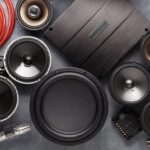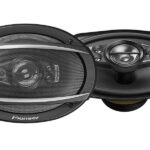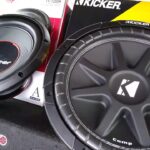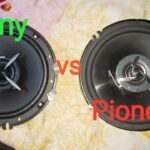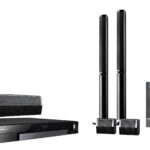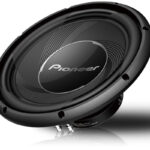To connect an equalizer to a Denon receiver, simply use RCA cables to connect the equalizer’s outputs to the receiver’s tape monitor inputs. The Denon receiver is a popular choice for home audio systems, known for its high-quality sound and versatility.
If you’re looking to enhance your audio experience by adding an equalizer to the mix, it’s important to know how to properly connect it to the receiver. By following a few simple steps, you can easily connect the equalizer to your Denon receiver and fine-tune the audio to your preferences.
We will provide you with a straightforward guide on how to connect an equalizer to a Denon receiver, ensuring optimal audio performance.
Equipment Required
To connect an equalizer to a Denon Receiver, you will need three main pieces of equipment: the Denon Receiver itself, an equalizer, and audio cables. The Denon Receiver is the central hub that will receive and process the audio signals. The equalizer is a device that allows you to adjust the audio frequencies to optimize the sound quality. Audio cables are necessary to connect the equalizer to the receiver.
First, ensure that you have the appropriate audio cables. You will need two pairs of RCA cables for a stereo setup or three pairs for a surround sound system. Connect one end of the RCA cables to the output jacks on the receiver labeled “Line Out” or “Pre-Out” and the other end to the input jacks on the equalizer labeled “Line In.” Make sure to match the left and right channels correctly.
Next, use additional RCA cables to connect the output jacks on the equalizer labeled “Line Out” to the appropriate input jacks on the receiver. Again, ensure that the left and right channels are properly matched.
Once the physical connections are made, turn on the Denon Receiver and the equalizer. Go to the receiver’s settings menu and select the appropriate input source for the equalizer. Adjust the equalizer settings to your personal preference, taking care not to overdo or distort the audio frequencies.
Step 1: Understand The Equalizer Connections
When connecting an equalizer to a Denon receiver, it is important to understand the different connections involved.
The equalizer will typically have input and output ports that allow you to connect it to your receiver. The input ports receive the audio signal from your source device, such as a CD player or a turntable. The output ports then send the equalized audio signal to your receiver.
It is essential to identify the correct ports on both the equalizer and the receiver for a proper connection. The input ports on the equalizer are where you will connect the audio cables from your source device. The output ports on the equalizer will then be connected to the corresponding input ports on your Denon receiver.
Understanding these connections will ensure that the audio signal passes through the equalizer correctly and allows you to adjust the sound using the equalizer’s basic functions
Step 2: Gather The Necessary Cables
If you want to connect an equalizer to your Denon receiver, the first thing you need to do is determine the types of cables needed. Different models of Denon receivers may require different types of cables. You can refer to the user manual or the manufacturer’s website to find out the specific cables required for your model. Once you have determined the types of cables, check if you already have them. If not, you will need to purchase the necessary cables. Ensure that the cables you buy are compatible with both the Denon receiver and the equalizer. It’s important to have the right cables to ensure a proper and stable connection between the two devices.
Step 3: Turn Off And Unplug The Denon Receiver
To safely connect an equalizer to your Denon Receiver, it is important to follow proper precautions. Start by turning off the receiver and unplugging it from the power source. This will prevent any electrical shocks and ensure your safety during the process. It is crucial to handle the power connection with care. Additionally, disconnecting the power will protect the receiver from any potential damage. Remember to treat the equipment delicately and prioritize safety at all times.
Step 4: Identify The Appropriate Connections
When setting up your Denon Receiver, it is important to properly connect the equalizer to optimize your audio experience. In Step 4, you need to identify the appropriate connections on the rear panel of the receiver. Look for the audio input and output ports, which are usually color-coded for easy identification. These ports allow you to connect various audio devices to your receiver.
In addition, you should locate the preamp output and main-in input. The preamp output is where you will connect the equalizer’s input, while the main-in input is where you will connect the equalizer’s output. This allows the equalizer to intercept the audio signal and adjust it before it reaches the receiver’s amplifiers and speakers.
Taking the time to correctly identify these connections will ensure that your equalizer is properly integrated into your audio setup, resulting in enhanced sound quality and an immersive listening experience.
Step 5: Connect The Cables
Connect the equalizer to your Denon Receiver by following these simple steps:
| Step 5 | Connect the cables |
| Subheading: Connect one end of the audio cable to the output port of the equalizer | |
| Take one end of the audio cable and plug it into the output port of the equalizer. Make sure it is securely connected. | |
| Subheading: Connect the other end of the cable to the input port of the Denon Receiver | |
| Now, take the other end of the cable and insert it into the input port of the Denon Receiver. Again, ensure a firm connection. | |
| Subheading: Repeat the process for the other channel | |
| If you have multiple channels on your equalizer and Denon Receiver, repeat the previous steps for each channel, connecting the audio cables accordingly. |
By following these instructions, you can easily connect your equalizer to your Denon Receiver and enhance your audio experience.
Step 6: Power On The Denon Receiver
To power on the Denon Receiver, start by plugging in the power cable into a suitable power outlet. Ensure that the cable is securely connected to the receiver’s power input. Once the power cable is plugged in, press the power button on the receiver to turn it on. You should see the receiver’s display light up and the device will start initializing. Give it a few seconds to fully power on.
Step 7: Set Up The Equalizer
When setting up your equalizer with a Denon Receiver, it’s important to understand the controls and how to adjust the frequency bands properly.
The equalizer controls allow you to fine-tune the audio output to your liking. Each frequency band corresponds to a specific range of tones, such as bass or treble. By adjusting the sliders for each band, you can increase or decrease the volume level for that particular range.
To achieve the desired sound quality, it’s crucial to carefully listen to the audio while making adjustments. Start by playing a familiar audio source and gradually adjust each frequency band according to your preferences. For example, if you want more bass, increase the sliders in the lower frequency bands.
| Frequency Band | Adjustment |
|---|---|
| Bass (20-250 Hz) | Increase for more bass, decrease for less |
| Midrange (250 Hz-2 kHz) | Adjust for vocals and instruments |
| High Frequency (2 kHz-20 kHz) | Tweak for treble and high-end details |
Remember, finding the optimal equalizer settings can vary depending on personal preference and audio equipment. Take your time to experiment and find the perfect balance for your listening enjoyment with your Denon Receiver.
Step 8: Test The Equalizer
Step 8: Test the equalizer
Now that you have successfully connected your equalizer to your Denon Receiver, it’s time to test it out. The best way to do this is by playing some music or audio that you are familiar with.
Start by playing a song or audio track on your device and make sure it is connected to the Denon Receiver. Once the music starts playing, pay attention to the sound quality and the overall balance of the audio.
Next, make adjustments to the equalizer settings to enhance the sound according to your personal preference. You can boost or lower specific frequencies to achieve the desired effect. For example, if you want more bass, try increasing the low-frequency range. If you prefer more treble, increase the high-frequency range.
Take your time to experiment with different settings and listen to the changes in sound. Remember to save any changes you make for future use.
Step 9: Troubleshooting Common Issues
Having trouble with connecting your equalizer to your Denon receiver? Don’t worry, we’ve got you covered. In this troubleshooting guide, we’ll address common issues that you may encounter during the setup process.
If you’re not getting any sound from your Denon receiver after connecting the equalizer, there are a few things you can check:
- Ensure that the equalizer is powered on and connected properly to the receiver.
- Verify that the audio cables are securely plugged into the correct inputs and outputs on both the equalizer and receiver.
- Check the receiver’s audio settings to ensure that the correct input and output sources are selected.
- Make sure that the volume levels on both the equalizer and receiver are set appropriately.
If you’re experiencing distorted sound after connecting the equalizer, consider these troubleshooting steps:
- Confirm that all audio cables are undamaged and tightly connected.
- Check if the equalizer settings are adjusted properly to prevent over-amplification or distortion.
- Try connecting the equalizer to a different set of audio inputs and observe if the distortion persists.
- Ensure that any additional audio processing or effects, such as tone controls or filters, are disabled or set to neutral settings.
If you’re experiencing issues with the connection between your equalizer and Denon receiver, try the following:
- Inspect all cables for any visible damage or loose connections.
- Consider using high-quality audio cables to ensure a stable and reliable connection.
- If using an audio adapter, ensure it is compatible and properly connected.
- Restart both the equalizer and receiver, allowing them to establish a fresh connection.
By following these troubleshooting tips, you’ll be able to resolve common issues and enjoy optimal audio quality with your equalizer and Denon receiver.
Step 10: Enjoy The Enhanced Audio Experience
Connecting an equalizer to your Denon receiver is a simple process that can greatly enhance your audio experience. Once you have followed the proper steps and made all the necessary connections, you can sit back and enjoy the improved sound quality.
One way to enhance your audio experience is by experimenting with different equalizer settings. By adjusting the various frequencies, you can fine-tune the sound to your preferences. Whether you prefer more bass or a clearer treble, the equalizer can help you achieve the desired audio output.
Remember to take into account the room acoustics and the type of speakers you are using when adjusting the equalizer. Each environment and speaker setup may require unique settings to optimize the sound quality.
So, go ahead and connect your equalizer to your Denon receiver, follow the steps carefully, and then sit back and enjoy the enhanced audio experience. Experiment with the equalizer settings to find the perfect balance that suits your listening preferences.
Conclusion
To sum it up, connecting an equalizer to a Denon Receiver is a straightforward process that can greatly enhance your audio experience. By following the steps mentioned in this guide, you can effortlessly link these two devices and fine-tune your sound output according to your preferences.
Remember to consult the user manuals for both the equalizer and the receiver for specific instructions. Embrace the power of customization and take your listening enjoyment to new heights.
Frequently Asked Questions For How To Connect Equalizer To Denon Receiver
How Do I Connect An Equalizer To My Denon Receiver?
To connect an equalizer to your Denon receiver, you will need audio cables and a compatible equalizer. Connect the audio cables from the equalizer’s output to the receiver’s input, and the cables from the receiver’s output to the equalizer’s input.
Make sure to follow the instructions provided with the equalizer for proper setup.
Why Should I Connect An Equalizer To My Denon Receiver?
Connecting an equalizer to your Denon receiver allows you to adjust the sound frequencies to your personal preferences. This can enhance the audio quality by fine-tuning the bass, treble, and other audio elements. It provides greater control over the sound output, resulting in a more immersive listening experience.
What Audio Cables Do I Need To Connect An Equalizer To My Denon Receiver?
To connect an equalizer to your Denon receiver, you will need RCA audio cables. These cables have red and white connectors on each end, which correspond to the left and right audio channels. Ensure that the cables are long enough to reach between the equalizer and the receiver without straining or bending excessively.
Can I Connect Multiple Equalizers To My Denon Receiver?
It is possible to connect multiple equalizers to your Denon receiver, but it requires additional equipment such as a switcher or an audio mixer. These devices allow you to route the audio signal between the multiple equalizers and the receiver.
It is important to ensure that all connections are properly set up to avoid any signal loss or interference.
